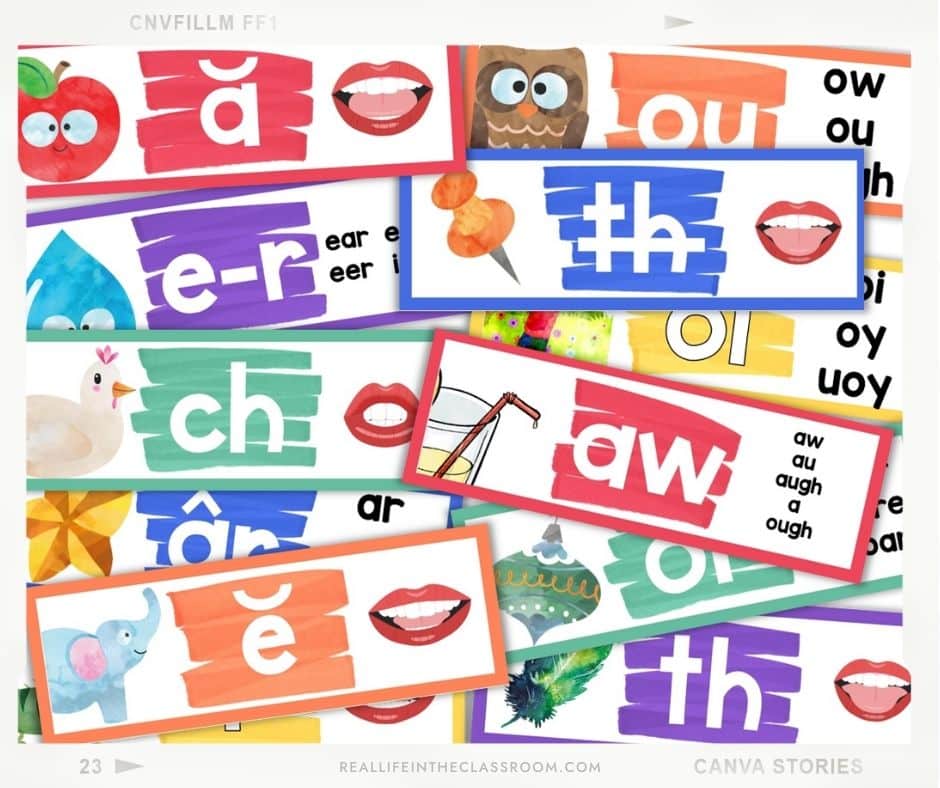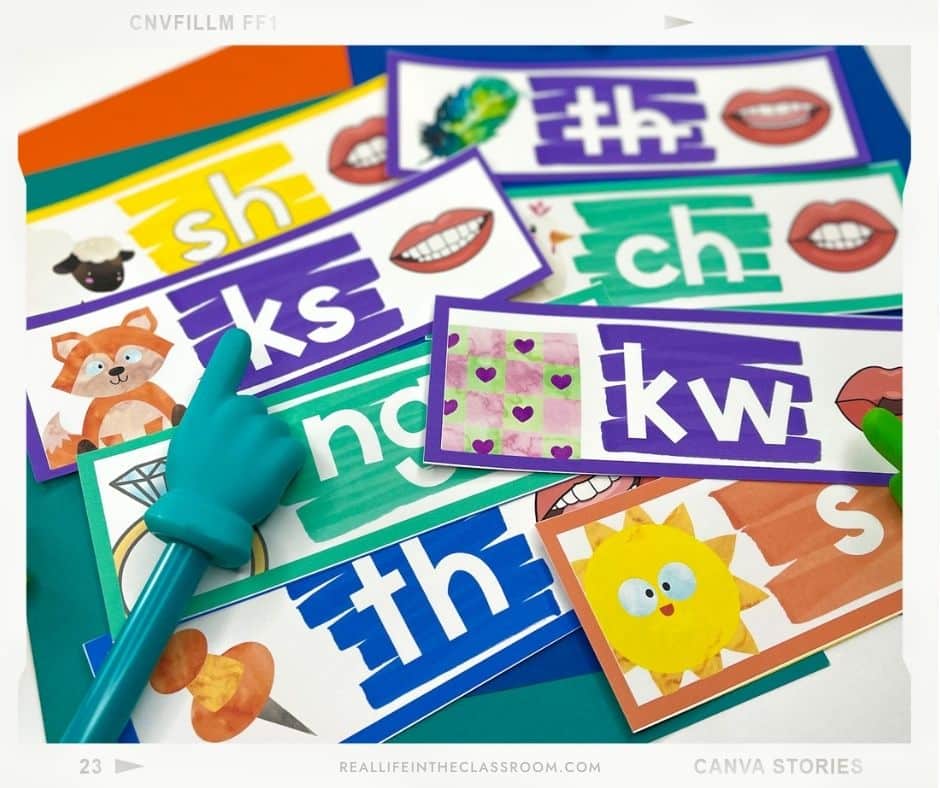Inside: Learn what Sound Walls are, why they’re more effective than traditional Word Walls, and how to make the switch.
I gazed around my classroom, clipboard in hand. My students were in various stages of the writing process, the only sounds being the classical music I played softly in the background and their pencils scratching the paper. I settled myself into a tiny chair next to Amber*, who was working on a narrative piece about baking cupcakes with her grandmother.
Amber was staring thoughtfully across the room, her pencil resting against her chin. I followed her gaze and realized with absolute joy that she was looking at our word wall.
My teacher’s heart swelled. Yasss! Nothing better than catching students organically using one of the strategies I’ve taught for spelling tricky words.
“Hi, Amber! Can you tell me what you’re working on?” I asked.
“Yes… I’m writing about baking with Nana. I want to write the word any, but I can’t remember how to spell it… and I can’t find it on the Word Wall.”
I glanced at the Word Wall and quickly located the word- it was one of the first words on the wall, right under the Aa header. I pointed it out to her and she pulled back in shock- “Wait, THAT’S how you spelled any?”
Ohhhhhhh. Amber had sounded out any and heard the phonemes /e//n//e/. She had been looking under the Ee card.
I did a quick micro lesson on shwa sounds like the a in the word any and moved on to the next student. But I couldn’t forget about that exchange.
I had seen students struggle to locate words on the Word Wall before for similar reasons, but this time I couldn’t shake it. The whole purpose was the help students spell words. But it wasn’t working when they needed it the most.
It. Wasn’t. Working.
And it was time to let my Word Wall go.
Enter the Sound Wall
A sound wall supports students by focusing on the articulation of sounds/phones and the various letter/letter patterns that represent the phonemes in words. This allows students to see beyond individual letters and understand how sounds are made and represented in written language.

Table of Contents
How Sound Walls Benefit Students’ Understanding of Sound-Letter Relationships
Supporting the development of sound-letter relationships can be a daunting task for language learners of any age—especially those for whom English isn’t their first language. That’s why sound walls are such a valuable learning tool. By focusing on the articulation of phonemes and letter patterns, they enable students to visualize and better understand how phonemes work together to form words. This recognition can give them the confidence they need to learn, practice, and master new sound-letter combinations. 💥
Step-by-Step Guide: Creating a Sound Wall in Your Classroom
Creating a sound wall is a simple way to help your students articulate sounds/phonemes correctly in words. All you need are a few supplies and some creativity!

How to Make Your Own Sound Wall
- List the sounds/spellings: Make a list of the sounds/spellings you will be teaching. Consult your district’s scope and sequence guide if you need to.
- Choose a spot: Decide where you will put your sound wall in your classroom. You want to choose a spot that will give you enough space and you want students to be able to see it from various spots in the classroom.
- Plan for organization: Decide how you will group the sounds. Will you group them as consonants, vowels, digraphs, etc? Or will you sort them by articulation- stops, liquids, nasals, affricates, etc?
- Find or create images: For each card, you will want to include the phoneme and an anchor image that has that sound at the beginning of the word that names it. You may want to draw your own images for each card, but it would probably be easier to find images online. You can use Google Images to find images to use.
- Make the cards: You can use a program like Microsoft PowerPoint or Canva to create the cards, or you can cut, paste, and hand-write the letters for each phoneme to make them the old-fashioned way.
So, let’s be real. Making your own sound wall requires quite a bit of work and the process can be pretty time-consuming. If you’re looking for a faster way to get your it up and running, check out my Sound Wall resource by clicking the link! Simply print the cards out and cut them apart. They’ll be ready to go up in no time!

This resource includes two different versions, and every card also includes a mouth image to help with articulation. Two different sets of headers are included as well. Click here to read more about it.
Unlocking the Full Potential of Your Sound Wall
Once your sound wall is up in your room you’ll want to get the most out of it. Instead of simply focusing on sound production, your display can be used to practice spelling and other lessons related to language arts. By leveraging sound walls and creating exciting learning opportunities, you can create an environment where students become more confident in their ability to produce sounds accurately.

Some Tips for Using Sound Walls Effectively
- Introduce the sound wall: Start by explaining the purpose of the sound wall and how it can help your students with their reading and writing.
- Add phonemes gradually: It can be overwhelming for students to have all the phonemes up at once, so consider adding them gradually over time. You can start with just a few phonemes and add more as the year goes on.
- Use the sound wall as a reference during instruction: During phonics and reading lessons, refer to it frequently to help students make connections between the sounds and letters they are learning.
- Encourage students to use the sound wall during independent work: When students are writing or reading on their own, encourage them to refer to it to help them with spelling and decoding.
- Play games with the sound wall: You can play games like “Find the Phoneme” or “I Spy” with the display to help students practice identifying different phonemes.
- Review and assess regularly: Make sure to review the phonemes on the sound wall regularly to reinforce learning and assess student progress. You can do this through games, quizzes, or other formative assessments.
Any connections you can make to the sound wall during the day are great… you want to call attention to it as much as possible (without being annoying) so your students remember to use it.
My Vowel Sound bookmarks are a great way to help students learn proper articulation and they coordinate perfectly with my Sound Wall Resource. Best part? You can grab these colorful bookmarks for free by clicking the link.

Overall, the sound wall is a powerful tool for helping students develop their phonemic awareness and become stronger readers and writers. By incorporating it into your daily instruction and encouraging students to use it as a reference, you can help support their learning and growth.
Traditional Word Walls Are Out and Sound Walls are In
Okay, so now that we’ve covered what a sound wall is, how to make one, and how to use it, it’s time to address the elephant in the room. Are they really better than traditional word walls?
And the answer is yes, yes they are. (At least in my opinion).
First, sound walls provide a visual representation of the sounds (phonemes) that make up our language and help students to connect those sounds to the written letters that represent them. This can be especially helpful for students who struggle with phonemic awareness or have difficulty decoding unfamiliar words.

Additionally, they just make more sense when it comes to organization. By organizing words by their sounds rather than their alphabetical order, students can better see the patterns and relationships between words. This can help them learn to spell new words by breaking them down into their phonemes, and it also allows for more logical reading practice.
Also, sound walls are very versatile and can be used to practice a variety of language arts skills like spelling, decoding, writing, and vocabulary building.
Sound walls are awesome, friends!
Ease into the Transition: Adjust Your Current Word Wall Instead of Replacing It
If you’ve been using a word wall for a long time, transitioning to a sound wall can sound intimidating. But it doesn’t have to be! Make the switch gradually, and do it in a way that makes sense for you and your students.
You may want to start by examining your current word wall and see if you can adjust it rather than replace it completely.
One way you can do this is by replacing the letter headers with sound wall phoneme cards.
- For example, take down the “Cc” card and replace it with a sound wall card that includes a letter for the phoneme (ex: /k/), an anchor image (ex: cat), and a mouth image demonstrating articulation.
- Then, look at the words in the section and determine if they still belong in that list. For example, for the /k/ card you would leave words such as could, can, and can’t but you’d have to move city, since the c at the beginning is making the sound of /s/.
- You could move city to the list of Ss words and replace the Ss card with a card with /s/, an anchor image of a sun, and the appropriate mouth image. And so on. (I promise this isn’t nearly as complicated as it sounds once you get the hang of it).

You could do this all at once, or rearrange a couple of lists a day.
Doing so will create an environment that is conducive to transitioning towards a sound wall while still maintaining some of the support of the word wall. Keep in mind that making the switch is an ongoing process that takes time and should be implemented with care and patience.
My Sound Wall resource is the perfect set to use if you are interested in transitioning gradually. The horizontal shape of the cards makes it unique from most sound wall cards out there and will work great with existing word walls- or for teachers that want to use a sound wall similarly. Be sure to check it out!
Say Goodbye to Word Walls and Hello to Sound Walls
If you’re looking for a way to support your students in articulating sounds and representing the various letter patterns that represent those sounds, a sound wall is a great tool. Sound walls are easy to create and can be used in a variety of ways to support student learning. Plus, they’re more effective than traditional word walls. You won’t have to worry about students wasting time searching for cards in the wrong section anymore! It makes so much more sense to put the phone card under the /f/ (sound) heading than the Ff (letter) heading!
So if you’re ready to make the switch from a word wall to a sound wall, check out my sound wall resource. It includes everything you need to get started, plus some tips for using sound walls effectively in your classroom.







